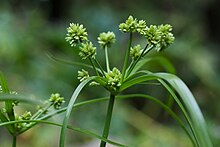Cyperus eragrostis is a species of sedge known by several common names, including tall flatsedge, nutgrass, tall nutgrass, umbrella sedge, chufa, Earth almond, zula nuts, edible galingale and pale galingale.[1]
| Tall flatsedge | |
|---|---|

| |
| Scientific classification | |
| Kingdom: | Plantae |
| Clade: | Tracheophytes |
| Clade: | Angiosperms |
| Clade: | Monocots |
| Clade: | Commelinids |
| Order: | Poales |
| Family: | Cyperaceae |
| Genus: | Cyperus |
| Species: | C. eragrostis
|
| Binomial name | |
| Cyperus eragrostis | |
| Synonyms | |
|
Cyperus vegetus | |


Distribution
editThis species is native to the West Coast of North America from California to Washington, the Southeastern United States, Jamaica, and South America.[2][3][4][5] It has become naturalized elsewhere in some regions in the northeastern and southeastern U.S., Europe, South Africa, and various oceanic islands (Azores, Canary Islands, Ryukyu Islands, Norfolk Island, Easter Island, etc.).[3][6][7] It can become a weed where it is introduced; it has been known to infest rice fields.
It is found in riparian areas, roadsides ditches, damp grasslands, and other moist habitats.[5]
Description
editCyperus eragrostis is an herbaceous perennial growing from rhizomes. It is a green sedge with tall, erect stems, 10–90 centimetres (3.9–35.4 in) in height. Long, thin, pointed leaves radiate from the top, similar to parasol ribs.
Its flowers are found within tough, rounded, greenish-yellow or beige spikelets. Fruiting is in the summer.[5]
See also
editReferences
edit- ^ USDA plant guide
- ^ GRIN-Global Web v 1.9.4.2: Taxonomy of Cyperus eragrostis
- ^ a b Kew World Checklist of Selected Plant Families
- ^ USDA . accessed 1.23.2013
- ^ a b c Cyperus eragrostis in Flora of North America @ efloras.org . accessed 1.23.2013
- ^ Altervista Flora Italiana, Zigolo, Tall Flatsedge, Cyperus eragrostis Lam. includes photos plus distribution maps for Europe and North America
- ^ Flora of China Vol. 23 Page 229, 密穗莎草 mi sui suo cao Cyperus eragrostis Lamarck, Tabl. Encycl. 1: 146. 1791.
External links
edit- USDA Plants Profile for Cyperus eragrostis (tall flatsedge)
- Calflora Database: Cyperus eragrostis (Tall cyperus, Tall flatsedge)
- Jepson Manual eFlora (TJM2) treatment of Cyperus eragrostis
- UC CalPhotos gallery of Cyperus eragrostis